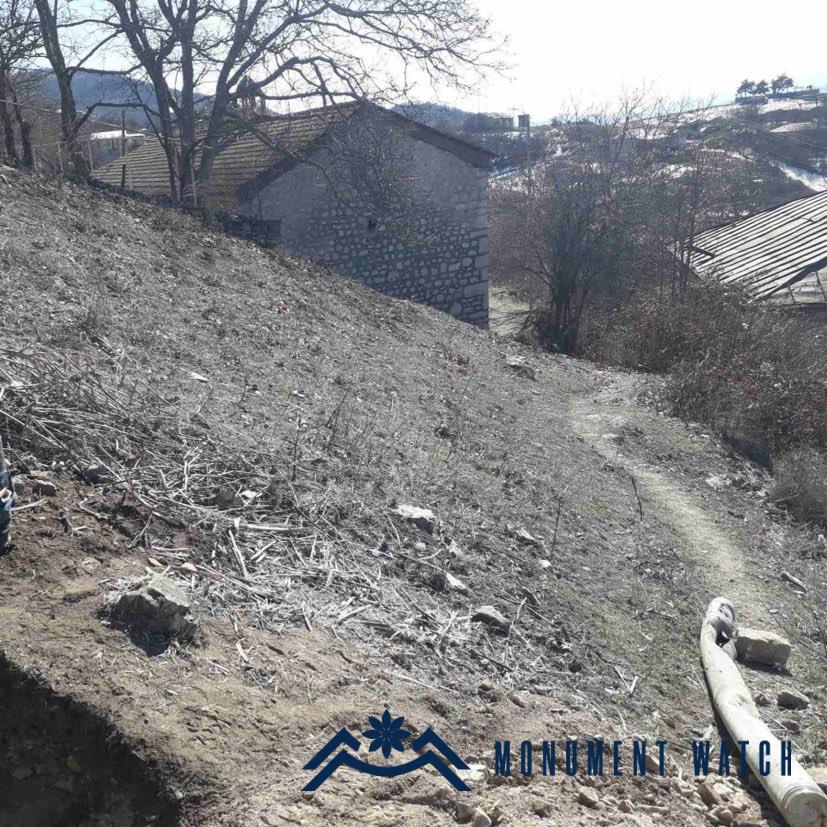On the attack on Surb Astvatsatsin Church in Karmir Gyugh village in Artsakh caused by Azerbaijan during the 44-day war
On February 21, 2023, Nerses Garegin Asryan on his Facebook page presented another evidence of the attack on the Armenian cultural heritage caused by the Armed Forces of Azerbaijan during the 44-day war.
As Mr. Asryan notes, we are talking about the church of Surb Astvatsatsin in Karmir Gyugh village of Askeran region in Artsakh, which miraculously escaped destruction during the war. This missile fell literally a few meters from the church, without damaging it, and stuck in the ground nearby. Until now, we did not notice it: it was covered either with vegetation or snow" https://www.facebook.com/garegin.asryan/posts/pfbid02x4r2j7Dk2Ye9bgJ5MbvdrUTaenGT7Y1tsNR318y1Tbnx6vMy71dtdurGyKSBTMNgl . The missile was neutralized by the relevant services of Artsakh and removed.
Our answer
The main provision on the protection of cultural property is formulated in the 4th article of the Convention for the Protection of Cultural Property in the Event of Armed Conflict of 1954: “States are obliged to respect both their own cultural property and the cultural property of the other party, refraining from acts of hostility and repressive measures” (Hague Convention for the Protection of Cultural Property in the Event of Armed Conflict 1954, article 4, UNESCO, http://www.unesco.org/new/en/culture/themes/armed-conflict-and-heritage/convention-and-protocols/1954-hague-convention/ ).
The prohibition of attacks on cultural property in the event of war/armed conflict is also enshrined in international humanitarian law, which has customary law status; that means, they have international binding force. Rule 38 of International Humanitarian Law states: “Each party to the conflict must respect the cultural property and take all necessary measures to avoid damage to buildings dedicated to religion, art, science, education or charitable purposes and historic monuments unless they are military objectives.” (Customary IHL, Practice Relating to Rule 38. Attacks against Cultural Property, https://ihl-databases.icrc.org/customary-ihl/eng/docs/v2_cou_be_rule38 ).
And the 40th rule completes what has been said, stating that each party to the conflict must protect the cultural heritage. “Any form of theft, pillage or misappropriation of, and any acts of vandalism directed against, property of great importance to the cultural heritage of every people is prohibited” (Customary IHL Rule 40. Respect for Cultural Property, https://ihl-databases.icrc.org/customary-ihl/eng/docs/v1_rul_rule40 ).
According to Article 7 of the Second Hague Protocol, adopted in 1999, in order not to damage cultural heritage values during an attack, the parties to the conflict are obliged to:
a) do everything feasible to verify that the objectives to be attacked are not cultural property protected under Article 4 of the Convention of 1954;
b) take all feasible precautions in the choice of means and methods of attack with a view to avoiding, and in any event to minimizing, incidental damage to cultural property;
c) refrain from deciding to launch any attack which may be expected to cause incidental damage to cultural property;
d) cancel or suspend an attack if it becomes apparentit may cause incidental damage to cultural property which would be excessive in relation to the concrete and direct military advantage anticipated https://ihl-databases.icrc.org/en/ihl-treaties/hague-prot-1999/article-7?activeTab=undefined.

